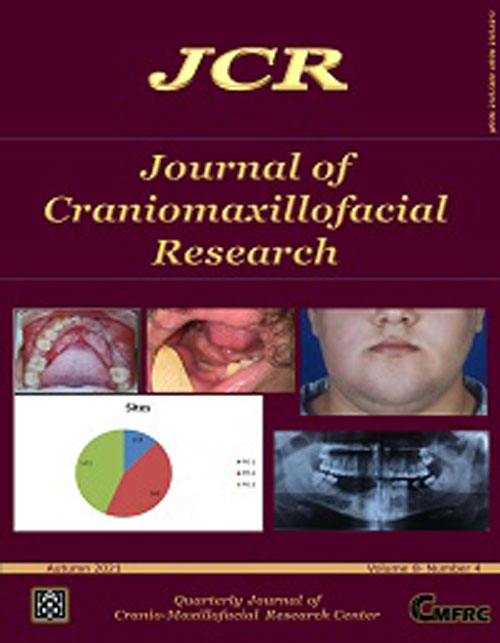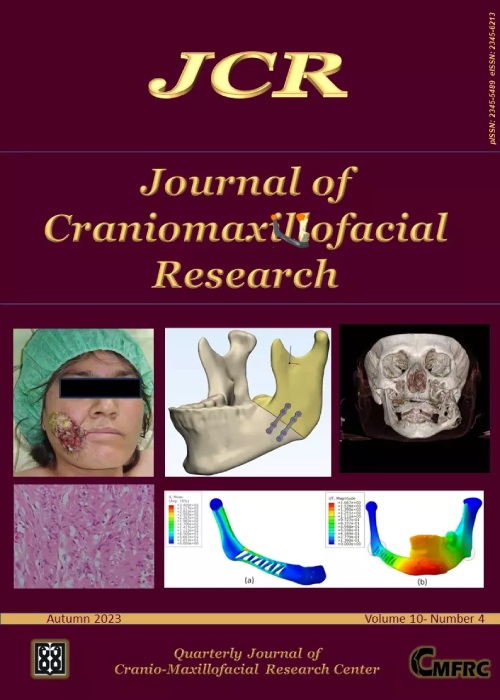فهرست مطالب

Journal of Craniomaxillofacial Research
Volume:8 Issue: 4, Autumn 2021
- تاریخ انتشار: 1401/04/08
- تعداد عناوین: 7
-
-
Pages 164-171Aim and Objective
The aim of this study was to evaluate the effect of maxillary protraction on airway dimensions in growing patients.
Materials and MethodsThe research was conducted using literature reviews. Articles included in databases such as PubMed, Embase, Google Scholar and Cochrane were reviewed via inputting keywords such as maxillary protraction, maxilla retrusion, retrognathic, class III malocclusion, face mask, reverse head gear, Delaire, protraction head gear, reverse occlusion, anterior crossbite, growing patient, bone anchorage, dental anchorage. The search period for articles ranged from January 2005 to April 2021.
Results7 articles with inclusion criteria were included in the study; the results of the studies showed the effectiveness of maxillary protraction on increasing the dimensions of the airway. Studies have shown a significant increase in the size of the upper airway, especially the nasopharynx, following maxillary protraction with tooth-borne and bone-borne appliances.
ConclusionMaxillary protraction can increase the size of the upper airway in growing patients. However, further studies are needed to elucidate the effects on changes in the pharyngeal airway, respiratory indicators (such as the apnea-hypopnea index), and its long-term effects.
Keywords: Maxillary protraction, Maxilla retrusion, Retrognathic, Class III malocclusion, Facemask, Reverse head gear, Delaire, Protraction head gear, Reverse occlusion, Anterior crossbite, growing patient, Bone anchorage, Dental anchorage -
Pages 172-177Statement of the Problem
Mesenchymal tissue origin is one of the most common lesion in oral cavity. Most of these lesions are exuberant response to local irritation produces a soft tissue enlargement which are similar to neoplastic pathologic processes. Due to this diagnostic challenge the present study was conducted for reviewing the prevalence of soft tissue lesions.
Search StrategyThe English articles in scientific databases including Google Scholar, Sci- ence Direct, Medline, and PubMed, published between 2007 and 2019, were searched by using relevant keywords including oral soft tissue lesion, oral mucosal lesion, neoplastic soft tissue lesion, reactive lesion, hyperplastic lesion and non-neoplastic soft tissue lesion. Finally, forty-nine articles were reviewed in this study.
ConclusionFindings showed that the most diagnosed lesions were benign in nature, and inflammatory in origin. Among this reactive/non-neoplastic lesions, fibrotic lesions, such as irritation fibroma or fibrous hyperplasia, were the most abundant lesions reported. There is a pronounced female predilection, and reactive lesions are most common in the fourth to sixth decades of life. Regarding the location of reactive lesions, the gingival mucosa was the most common site of involvement. Tumoral lesions with the origin of vascular, fibrotic and fat were the most commonly reported tumors.
Keywords: Mesenchyme, Oral neoplasms, Reactive lesions, Mucosal lesion, Hyperplastic lesion -
Pages 178-186Objectives
Impacted teeth fail to erupt fully into the oral cavity within the expected time due to interferences with the jaw bone, adjacent tooth, or even the gingivae. The third molar impaction frequency is related to space deficiency in dental arches. This study investigated different patterns of third molar impaction in various skeletal malocclusions in anteroposterior and vertical dimensions.
Materials and MethodsIn this study, 362 panoramic and lateral cephalograms of the patients with orthodontic treatment indications were verified and investigated. The malocclusion type was determined and diagnosed using lateral cephalogram tracing.
Results39.2% of the patients were male, and 60.8% were female. The mean age of all the patients was 19.2 years; 35.6% of patients exhibited deep bite, and 32% had class II malocclusion. 44.5% of patients had two impacted third molars, and 23.5%, 20.7%, and 11.3% had four, one, and three impacted third molars, respectively. The frequencies of the mesio-angular pattern were 80.8% and 83.5% in the left and right quadrants of the mandible, respectively. The disto-angular pattern frequencies in the left and right quadrants of the maxilla were 91.1% and 93.3%, respectively.
ConclusionThe current study revealed that the highest incidence of third molar impaction was in the deep bite and class II malocclusions. The most common pattern of impaction was mesio- angular and disto-angular in the mandible and maxilla, respectively. Statistical analysis showed no significant relationship between the numbers and patterns of third molar impaction and skeletal malocclusion types.
Keywords: Third molar impaction, Skeletal malocclusion, Hypodontia -
Pages 187-196Introduction
Due to the high prevalence of diabetes in communities and the various oral health complications of this disease, a need for training the physicians treating diabetic patients is felt. This study aimed to compare the effect of interactive versus non-interactive virtual education on the knowledge and attitudes of physicians about oral health in diabetic patients and to assess their satisfaction from the programs.
Materials and MethodsThe educational intervention was implemented through the online continuous medical education (CME) site of Tehran University of Medical Sciences. Physicians applying to participate in the CME entered in one of the interactive or the non-interactive groups. After the training, the study questionnaires to assess knowledge (7 questions), attitude (8 questions), and backgrounds (6 questions), and physicians’ satisfaction (12 questions) with the training in this project, was provided to them through the same site. The analyzes were performed by linear regression test in SPSS version 26.
ResultsTotally 57 physicians, 27 in the interactive and 30 people in the non-interactive group participated. The score of knowledge and attitude were not different between the two groups after the intervention. Physicians’ satisfaction with interactive education was significantly higher. Physicians’ age showed a significant direct association (p<0.100) and the percentage of diabetic patients examined by learners showed a significant negative association (p=0.024) with their knowledge score.
ConclusionSince physicians’ satisfaction with interactive education has been significantly higher, it is suggested that this method be used in online CMEs.
Keywords: Virtual learning, Interactive education, Continuous medical education, Knowledge, Attitude, Satisfaction -
Pages 197-209Background
There is growing attention on anterior esthetics by both dentists and patients, which emphasizes
the need for conduct of study encompassing the anatomical features of an embrasure and correlating
with papilla fill. Hence the present study has been designed to meet these parameters, including food lodgement.AimTo assess the influence of anatomical and morphological characteristics of interdental embrasures on interdental papilla and food lodgement.
ObjectivesWere set as the following:1. Correlation of modified papilla index score (PIS) with interdental anatomical measurements as follows:a. Distance between Contact Point and Bone Crest (CP-BC).
b. Interdental Distance (IDD).
c. Embrasure Space Area (EA).
d. Crown Form (CF).
e. Papilla Length (PL).
2. To determine the optimal dimensions of interdental embrasure between maxillary incisors so as to be completely filled by normal healthy interdental papilla.
3. To correlate occurrence of food lodgement with Modified Papilla Index Score (PIS) and Embrasure Space Area (EA).Materials and Methods532 patients aged 18-58 years who had fully erupted permanent dentition and healthy
gingiva with probing depth≤3mm were included into the study. Quantitative analysis of interdental papillae were done using clinical parameters along with radiographic examination.ResultsThe clinical and radiographic assessment of 1312 interdental papillae revealed that the interdental anatomical factors viz (which are) CP-BC distance, IDD, EA, CF and PL significantly influenced the degree of papilla fill. The study also highlighted the possible occurrence of food lodgment in patients with open embrasures.
ConclusionEmbrasure anatomical parameters and papillary heightvary widely among individuals. Interdental
papillary deficiency is a relative phenomenon since it is an outcome of net influence of all the other parameters.
Keywords: Embrasures; Interdental papilla; Food lodgment; Papillary height; Crown form; Esthetics.Keywords: Embrasures, Interdental papilla, Food lodgment, Papillary height, Crown form, Esthetics -
Pages 210-219Introduction and Aims
Elderly people living in retirement homes are at higher risk of oral and maxillofacial diseases. Evidence has shown a clear relationship between poor oral health and possibility of aspiration pneumonia and gastrointestinal bleeding in old patients.
AimThe aim of this study was to determine the association between education received and working hours of nurses with their knowledge, attitude, and practice regarding the oral health of elderly in retirement homes.
Materials and MethodsIn this analytical study conducted in 2021 in Tehran, nurses working in retirement homes were invited to complete a questionnaire including demographics, knowledge (8 questions), attitude (7 questions), practice (10 questions) and barriers (1 question). The results were analyzed with SPSS-25 using linear regression.
ResultsThe mean age of the participants (n=78) was 40.28±8.9 years and 53.8% were female. Lack of cooperation among elders (56.4%) as well as lack of time (41.0%) were the most important barriers to oral health maintenance. Receiving education as a nurse/caregiver had positive relationship with the scores of knowledge, attitude, and practice. Age, frequency of regular dental visits and working time per week were significantly associated with practice.
ConclusionEducation received as a nurse/caregiver was an important predictor of oral health knowledge, attitude, and practice of nurses regarding elders. Due to the importance of oral health in general health of elderly, planning is needed to provide continuing education for nurses to oral health care and maintenance in older people.
Keywords: Attitude, Elderly, Knowledge, Oral health, Practice -
Pages 220-226
Central giant cell granuloma (CGCG) is a benign intraosseous pathology. A 17 years old male patient was referred and diagnosed with CGCG from mandibular right first molar to mandibular left second premolar. Enucleation and curettage of the lesion were completed as the main treatment. Involved teeth on the right, 41, 42, 43, 44, and 45 (FDI) were extracted. As adjunctive therapy, 120 mg Denosumab was injected subcutaneously. The patient received sixteen sessions of therapy through 11 months. Two, sixteen, and eighteen months follow-up after the first session of injection showed an acceptable improvement in bone contour. The patient experienced no functional or aesthetic impairment. Alongside the promising results of Denosumab as adjunctive therapy in the management and treatment of diseases such as CGCG, some questions have remained unanswered and no protocol has been determined. The authors of the current study recommend further researches to confirm Denosumab as a potential adjunctive or alternative in the treatment of CGCG.
Keywords: Central giant-cell granuloma, Denosumab, Follow-up, Mandible


